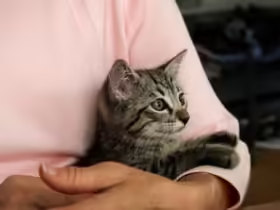Persian Cat Breed Information & Characteristics + Furry Frenemies? Tips for Introducing Dogs and Cats
Introducing a Persian cat to your family can be a wonderful experience. Known for their luxurious coats, calm demeanor, and friendly nature, Persian cats are a popular choice among cat lovers. However, when you also have a dog—or plan to adopt one—creating a harmonious environment between the two can be a bit more complex. Understanding Persian cat traits and knowing how to introduce them to dogs successfully is essential for a peaceful household.
In this comprehensive guide, we’ll dive into the specifics of the Persian cat breed and provide practical tips for introducing your Persian cat to a dog, ensuring that they coexist peacefully.
Part 1: Persian Cat Breed Information & Characteristics
Persian cats are one of the oldest and most revered cat breeds, cherished for their docile nature and striking appearance. Here, we’ll explore the key characteristics, history, and care tips for Persian cats.
History of the Persian Cat
The Persian cat’s origin can be traced back to the 1600s when long-haired cats from Persia (modern-day Iran) were first introduced to Europe. These cats became symbols of luxury and wealth, often found in the homes of aristocrats. Persian cats were also one of the earliest breeds recognized in cat shows in the 19th century.
Their popularity soared across Europe and North America in the following decades, and through selective breeding, the modern Persian cat—complete with its distinct flat face—emerged. Today, Persians remain one of the most recognized and beloved breeds worldwide.
Physical Characteristics
1. Luxurious Coat:
One of the most defining traits of the Persian cat is its long, thick, and silky coat. Their fur comes in a variety of colors and patterns, from solid white and black to tabby and tortoiseshell. However, this glamorous coat requires significant maintenance to keep it healthy and tangle-free.
2. Flat Face (Brachycephalic Features):
The modern Persian cat is known for its brachycephalic (flat-faced) appearance, characterized by a short nose, large eyes, and a round, broad head. While this feature gives them a unique look, it also brings some health challenges, including respiratory issues and tear duct problems.
3. Sturdy Build:
Persian cats have a medium to large build, with a sturdy, muscular body and short legs. Despite their plush appearance, they are not particularly active cats and prefer lounging around the house.
4. Eye Colors:
The eyes of Persian cats are another standout feature, often large and expressive. They can range in color, including copper, green, blue, or a combination, depending on the cat’s coat color.
Temperament
Persians are known for their calm and affectionate personalities. They are not the type of cat that will run around the house or demand attention at every turn. Instead, they enjoy quiet, relaxed environments and are content with lounging next to their human companions.
1. Quiet and Gentle:
Unlike more vocal breeds, Persian cats tend to communicate softly. They aren’t overly demanding or noisy, making them perfect companions for people who appreciate a peaceful household.
2. Affectionate but Independent:
Persians are known to bond strongly with their owners but aren’t overly clingy. They enjoy spending time with their human family members but are just as happy relaxing in a cozy spot by themselves.
3. Great for Calm Homes:
If you lead a quieter lifestyle, the Persian cat is ideal. They do well in calm environments and can easily adapt to apartment living. However, they aren’t typically suited for homes with a lot of chaos or high-energy activities.
Grooming and Health Considerations
Owning a Persian cat requires a significant commitment to grooming and health care due to their luxurious coats and unique facial structure.
1. Regular Grooming:
Because of their long fur, Persian cats need daily brushing to prevent mats and tangles. Without proper care, their coats can become matted, which may lead to skin infections.
2. Bathing:
Many Persian owners opt to bathe their cats regularly to keep their coats clean and reduce oil buildup. This also helps minimize shedding.
3. Eye and Face Cleaning:
Due to their flat faces, Persians often have issues with tear staining. Regularly cleaning the area around their eyes can help prevent tear stains and infections.
4. Health Issues:
Persian cats are prone to several health problems, including brachycephalic airway syndrome (respiratory difficulties due to their flat faces), dental issues, and Polycystic Kidney Disease (PKD). It’s important to get your Persian from a reputable breeder who screens for genetic conditions.
Nutrition
Persian cats benefit from high-quality, nutrient-dense food that promotes their coat health and overall well-being. Look for cat food rich in protein and omega fatty acids to support their luxurious fur and manage their energy levels.
Part 2: Furry Frenemies? Tips for Introducing Dogs and Cats
Introducing a new dog or cat into a household can be a challenge, especially when it involves two species with different instincts. However, with patience, the right techniques, and a deep understanding of both animals, it’s possible to foster a peaceful coexistence between your Persian cat and a dog.
Understanding Persian Cats and Dogs
Before you begin the introduction process, it’s essential to understand the nature of both Persian cats and the specific breed of dog you have (or plan to adopt).
- Persian Cats: As mentioned earlier, Persian cats are calm, gentle, and typically non-aggressive. They prefer quiet and are generally not very territorial. However, they may be wary of new animals, especially ones that are overly energetic or loud.
- Dogs: Depending on the breed, dogs can have various temperaments. Some dogs, particularly breeds known for their gentle and calm nature, may adapt well to a cat. Others, such as herding or high-energy breeds, may find it more difficult to adjust.
Preparing for the Introduction
1. Create Separate Spaces
Before bringing the two pets together, establish separate areas for each animal where they feel safe. This could be a bedroom, a quiet corner, or an area with a baby gate. Make sure each animal has access to food, water, and a litter box (for the cat) in their own space.
2. Swap Scents
Animals rely heavily on scent to understand their environment and one another. Begin the introduction process by swapping scents. You can do this by allowing the dog and cat to sniff each other’s bedding, toys, or even by petting one and then the other. This helps familiarize them with each other’s presence without direct contact.
3. Start with Controlled Interactions
When it’s time for a face-to-face introduction, make sure it’s done in a controlled environment. Keep the dog on a leash to prevent any sudden movements or lunges. Allow the Persian cat to move freely and observe from a distance.
Tips for a Successful Introduction
1. Take It Slow
The key to a successful introduction is patience. Start with short sessions where the dog and cat can see each other, but keep the encounters brief. Gradually increase the amount of time they spend in the same room.
2. Monitor Body Language
Keep a close eye on both the dog’s and the cat’s body language during interactions. Signs of aggression, fear, or stress (such as growling, hissing, raised fur, or stiff posture) should signal a need to separate them and try again later. Dogs should be discouraged from barking or chasing.
3. Reward Good Behavior
Use treats and praise to reinforce calm and positive behavior. Reward your dog for staying calm in the presence of the cat, and ensure the cat feels safe and secure by offering a cozy retreat during the process.
4. Keep Feeding Areas Separate
Cats and dogs can become territorial over food. Make sure to keep their feeding areas separate to prevent any food-related aggression or competition.
5. Provide Safe Retreats for Your Cat
Persian cats are not aggressive by nature and may feel overwhelmed by an excitable dog. Always provide your Persian with safe, elevated spaces where they can retreat and observe from a distance. Cat trees, shelves, or high perches work well.
6. Be Patient and Persistent
It can take weeks or even months for a cat and dog to become fully comfortable with each other. Be consistent with your approach, keep sessions calm, and don’t rush the process. Each animal has its own timeline for adjusting.
Breeds That Work Well with Persian Cats
Some dog breeds are known to be more cat-friendly than others. If you’re considering adding a dog to your household, look for breeds that are typically known for their gentle demeanor:
- Golden Retrievers
- Labrador Retrievers
- Cavalier King Charles Spaniels
- Basset Hounds
- Shih Tzus
These breeds are generally calm, gentle, and good-natured, making them a better match for Persian cats.
Conclusion
Owning a Persian cat is a rewarding experience filled with beauty, affection, and grace. Their serene demeanor and regal appearance make them an ideal companion for anyone seeking a calm and loving pet. However, their grooming and care needs require dedication, and introducing them to a dog requires patience and careful planning.
By following the tips provided in this guide, you can ensure that your Persian cat and dog will live harmoniously, forming a peaceful household











Leave a Reply